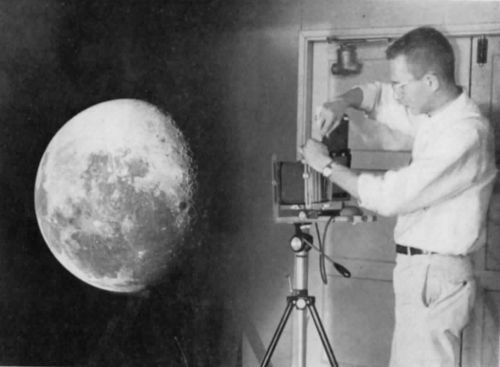Difference between revisions of "Rectified Lunar Atlas"
| Line 3: | Line 3: | ||
(glossary entry)<br /> <br /> | (glossary entry)<br /> <br /> | ||
==Description== | ==Description== | ||
| − | As part of [[Gerard%20Kuiper|G. P. Kuiper]]'s Moon-mapping program of the late 50s and 60s a unique atlas of the limb regions was made, the ''Rectified Lunar Atlas'' by Whitaker, Kuiper, Hartmann and Spradley. This large format, bound atlas showed each limb area as seen from directly overhead. Since this was made before lunar orbiters flew it was necessary to create it by projecting telescopic images of the Moon onto a large white sphere and then rephotographing the sphere from directly over the area of interest. In doing this Bill Hartmann discovered the multi-ring structure of [[Mare%20Orientale|Mare Orientale]] and other [[lunar%20basins|basins]]. This vertical view also allowed us crater catalogers (compiling the ''[[System%20of%20Lunar%20Craters|System of Lunar Craters]])'' to clean up many inconsistencies of limb nomenclature and recognize craters deserving names. [[D.W.G.%20Arthur|D.W.G. Arthur]] and [[Ewen%20Whitaker|E.A. Whitaker]] gave 68 new names or shifted earlier names to real formations in the ''Atlas''. Information from personal experience and ([[Whitaker|Whitaker]], 1999, pp. 234-5). <span class="membersnap">- | + | As part of [[Gerard%20Kuiper|G. P. Kuiper]]'s Moon-mapping program of the late 50s and 60s a unique atlas of the limb regions was made, the ''Rectified Lunar Atlas'' by Whitaker, Kuiper, Hartmann and Spradley. This large format, bound atlas showed each limb area as seen from directly overhead. Since this was made before lunar orbiters flew it was necessary to create it by projecting telescopic images of the Moon onto a large white sphere and then rephotographing the sphere from directly over the area of interest. In doing this Bill Hartmann discovered the multi-ring structure of [[Mare%20Orientale|Mare Orientale]] and other [[lunar%20basins|basins]]. This vertical view also allowed us crater catalogers (compiling the ''[[System%20of%20Lunar%20Craters|System of Lunar Craters]])'' to clean up many inconsistencies of limb nomenclature and recognize craters deserving names. [[D.W.G.%20Arthur|D.W.G. Arthur]] and [[Ewen%20Whitaker|E.A. Whitaker]] gave 68 new names or shifted earlier names to real formations in the ''Atlas''. Information from personal experience and ([[Whitaker|Whitaker]], 1999, pp. 234-5). <span class="membersnap">- tychocrater <small>Jul 28, 2007</small></span><br /> |
** {| class="captionBox" | ** {| class="captionBox" | ||
| class="captionedImage" | | | class="captionedImage" | | ||
| Line 30: | Line 30: | ||
<br /> | <br /> | ||
---- | ---- | ||
| − | + | </div> | |
Latest revision as of 17:09, 15 April 2018
Contents
Whitaker, Kuiper, Hartmann & Spadley: Rectified Lunar Atlas (1963)
(glossary entry)
Description
As part of G. P. Kuiper's Moon-mapping program of the late 50s and 60s a unique atlas of the limb regions was made, the Rectified Lunar Atlas by Whitaker, Kuiper, Hartmann and Spradley. This large format, bound atlas showed each limb area as seen from directly overhead. Since this was made before lunar orbiters flew it was necessary to create it by projecting telescopic images of the Moon onto a large white sphere and then rephotographing the sphere from directly over the area of interest. In doing this Bill Hartmann discovered the multi-ring structure of Mare Orientale and other basins. This vertical view also allowed us crater catalogers (compiling the System of Lunar Craters) to clean up many inconsistencies of limb nomenclature and recognize craters deserving names. D.W.G. Arthur and E.A. Whitaker gave 68 new names or shifted earlier names to real formations in the Atlas. Information from personal experience and (Whitaker, 1999, pp. 234-5). - tychocrater Jul 28, 2007
- {| class="captionBox"
| class="captionedImage" |
 |-
| class="imageCaption" | Hartmann with globe, from Kuiper (1964)
|}
|-
| class="imageCaption" | Hartmann with globe, from Kuiper (1964)
|}
Additional Information
- The atlas consists of 30 fields of 30x30° each illustrated on 30x38 cm sheets. Each field is shown with at least three illuminations (waxing, Full Moon, and waning) and accompanied by a gridded line drawing identifying the features.
- D.W.G. Arthur presented a report on nomenclatural changes introduced in the Rectified Lunar Atlas work, which was approved at the 1964 IAU meeting.
- The idea of rectifying lunar photographs by projecting them onto a globe seems to have been pioneered by Dr. F. E. Wright, who recorded the data directly with a photographic emulsion on the globe. Alter and Roques (1955) photographed Wright's globes from overhead the features of interest, and (according to the North American Atlas) in areas where Wright's globes had insufficient detail photographed new images projected onto a white wooden sphere.
- According to Carder (1962), the DMA had facilities for rectifying images by projection onto a sphere independent of those at the LPL.
LPOD Articles
Bibliography
- Whitaker, E. A.; Kuiper, G. P., Hartmann, W.K. & Spradley, L. H. 1963. Rectified Lunar Atlas - Supplement Number Two to the Photographic Lunar Atlas. Aeronaut. Chart Inform. Center.
- Alter, Dinsmore; Roques, Paul E. 1955. The Limb of the Moon. Publications of the Astronomical Society of the Pacific, Vol. 67, No. 397, p. 246 (with Plates 15, 16, 17 and 18)
- Carder, R. W. 1962. Lunar Charting on a Scale of 1:1000000. In: The Moon, (Kopal, Z., and Mikhailov, Z. K., editors) IAU Symposium 14, Academic Press, pp. 117-129.
- Kuiper, G. P. 1964. "The Lunar and Planetary Laboratory." Sky and Telescope Vol. 27. Part 2: February issue, pp. 88-92.
- MacRae, D. A. 1964. Review of Publications- Rectified Lunar Atlas. Journal of the Royal Astronomical Society of Canada, Vol. 58, p. 278.
- Spradley, L. H. "Lunar Globe Photography". Communications of the Lunar and Planetary Laboratory. 1(6), 31 -34. (PDF, shows a prototype image set for the atlas)